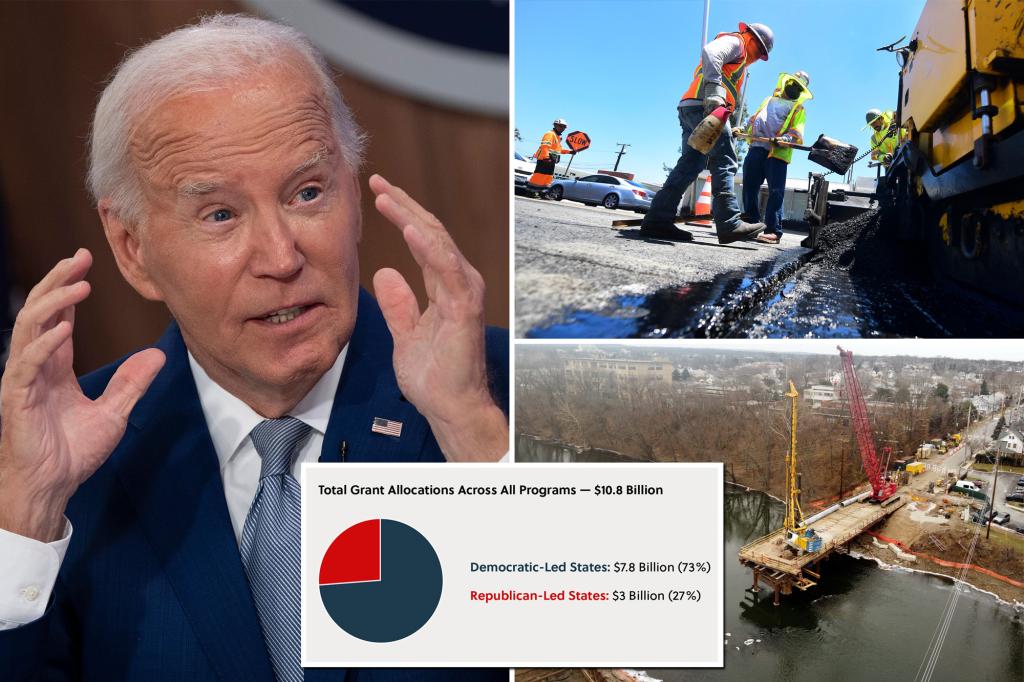A transportation watchdog report shared exclusively with The Post revealed that Democrat-led states have received 73% of all infrastructure funding doled out in the current fiscal year, despite making up fewer than half of the states in the country. The analysis by the Center for Transportation Policy focused on five grant programs totaling $10.8 billion in funding from the bipartisan Infrastructure Investment and Jobs Act passed in late 2021. Of this amount, $7.8 billion went to Democratic-led states, while GOP-led states received only $3 billion. The programs are managed by the Department of Transportation’s Federal Highway Administration and aim to rebuild and upgrade bridges, roads, railways, and other dilapidated infrastructure.
Despite Republican governors outnumbering Democratic governors 27-23, census figures show that 45% of Americans live in red states while 55% live in blue states. The analysis also included the District of Columbia as a “blue” jurisdiction. Jackson Shedelbower, the executive director of the Center for Transportation Policy, highlighted the influence of state leadership’s political identity in the distribution of federal tax dollars, emphasizing that infrastructure spending should be a bipartisan exercise and not a political tool. President Biden signed the $1.2 trillion bill in November 2021, allocating $660 billion for transportation funding with the FHWA managing around $365 billion.
Lawmakers from both parties have celebrated securing funding for transportation projects, with some benefiting directly from the legislative efforts. Senator Sherrod Brown (D-Ohio) received $19.5 million to improve a bike trail connecting his suburban neighborhood to downtown Cleveland, reflecting individual success stories associated with the funding distribution. Even when broken down by specific grant programs, Democratic-led states continued to receive more allocations than Republican-led states. For instance, the Nationally Significant Freight and Highway Projects (INFRA) program awarded $2.9 billion in grants, with $2.2 billion going to Democratic states and $674.5 million to Republican states.
Two other grant programs focused on bridge replacements, transport terminals, and overall infrastructure improvements distributed over $5 billion in investments, predominantly favoring Democratic states. The Safe Streets and Roads for All (SS4A) program prioritizing road safety and promoting equitable transportation networks allocated more funding to blue states than red states. The only program that allocated more grants to Republican-led states was the Rural Surface Transportation program, indicating some variance in allocation patterns across different infrastructure initiatives. President Biden emphasized the importance of delivering on campaign promises and meeting public expectations during a speech celebrating the passage of the Infrastructure Investment and Jobs Act.
In conclusion, the analysis of federal infrastructure funding distribution in the current fiscal year highlights a disproportionate allocation towards Democrat-led states compared to Republican-led states. Despite differences in state leadership, population distribution, and individual success stories, the overall trend points towards a higher investment in infrastructure projects in blue states. While both parties have celebrated the funding secured for transportation improvements, questions about the political influence on funding distribution, bipartisanship, and equitable resource allocation remain. The impact of these funding disparities on national infrastructure development, economic growth, and public welfare will likely continue to be a subject of discussion and debate in the political landscape.















